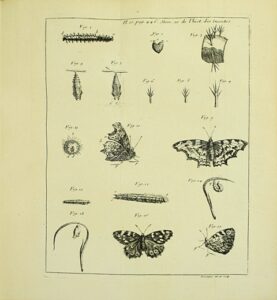Paris, Imprimerie royale, 1734-1738.
4 parts in 4 4to volumes [254 x 190 mm] (out of the 6 enclosed in the complete series) of: I/ (2) ll., 654 pp., (1) l., 50 out of pagination folding pl. ; II/ (1) l., 514 pp., (1) l., 40 out of pagination folding pl.; III/ (2) ll., xl pp., 532 pp., 47 out of pagination folding pl.; IV/ xxxiv pp., (1) l., xlvi pp., (1) l., 636 pp., 44 out of pagination folding pl., error in numbering p. 321. Foreword of the 2nd part bound at the time in the 4th volume. Full glazed light-brown calf, gilt fillet on the covers, spines ribbed and richly decorated, red morocco lettering pieces, red edges. Contemporary binding.
First edition and first state of the real first scientific history of insects. Brunet, IV, 1131, Nissen ZBI, 3315 ; En Français dans le texte, n°145 ; Rahir, La bibliothèque de l’amateur, 606.
This famous work, “this monument of intelligence and sensibility” founded the entomological science.
The printing of these Memoirs by the Royal Printing house happened between 1734 and 1742. Part 1 is dedicated to Caterpillars and Butterflies, part 2 presents the continuation of part 1 as well as a History of the Insects enemies to the Caterpillars, the third part exposes the History of the Worms eating leaves, of the Moths, of the false Moths, of the Greenflies, of the enemies of the Greenflies, of the false Greenflies, & the history of the Galls of the plants & of their Insects, part 4 printed in 1738 deals with the History of the Gallinsects, of the Progallinsects and of the two-winged Flies. Have also been published after that a 5th and a 6th volume, not included in our copy: the History of several four-winged Flies, and a supplement about two-winged Flies.
“This work, full of curious and very accurate facts, isn’t finished; the author still had to deal with crickets and grasshoppers […] which would have made several other volumes. Those we have won’t be less consulted fruitfully for the parts they deal with though” (Brunet).
Réaumur is a great entomologist: he is interested about the little insects and particularly about the study of invertebrate, that neither Diderot nor Buffon have included in their respective works, the Encyclopedia and the Natural History. He studies the life of ants or also the digestive system of bees, he rises up against Buffon’s experiences and rejects the principle of spontaneous generation. He will largely contribute to the progress of natural sciences by publishing his numerous entomological observations in his great twelve volume work, his Mémoires pour servir à l’histoire des insects (Memoirs to serve the history of insects) (1734-1742).
“Réaumur offers the most convincing, the most attentive and the most moving panorama that can exist about the infinitesimal” (En Français dans le texte, 145).
Well-known for its great accuracy, this treatise is illustrated, in these four first parts, with 181 large folding plates, finely engraved on copper by Simmoneau, Haussard, Fillioeul and Lucas that illustrate caterpillars, butterflies, flies, cicadas, bees and wasps in their natural habitat. The plates are here in first state, which is recognizable “by the beauty of the engravings proofs, which are all printed on a strong paper and large enough to go over with all the size of the plate all the margins of the volumes” (Brunet).
Very beautiful copy preserved in its seducing contemporary glazed light-brown calf binding.
See less information

![Mémoires pour servir à l’Histoire des insectes [Tome premier – quatrième].](https://www.camillesourget.com/wp-content/uploads/2023/03/Reaumur_pl1.jpg)
![Mémoires pour servir à l’Histoire des insectes [Tome premier – quatrième]. - Image 2](https://www.camillesourget.com/wp-content/uploads/2023/03/Reaumur_titre.jpg)
![Mémoires pour servir à l’Histoire des insectes [Tome premier – quatrième]. - Image 3](https://www.camillesourget.com/wp-content/uploads/2023/03/Reaumur_rel.jpg)
![Mémoires pour servir à l’Histoire des insectes [Tome premier – quatrième]. - Image 4](https://www.camillesourget.com/wp-content/uploads/2023/03/23.-Reaumur-fig.jpg)
![Mémoires pour servir à l’Histoire des insectes [Tome premier – quatrième]. - Image 5](https://www.camillesourget.com/wp-content/uploads/2023/03/Reaumur_pl2.jpg)
